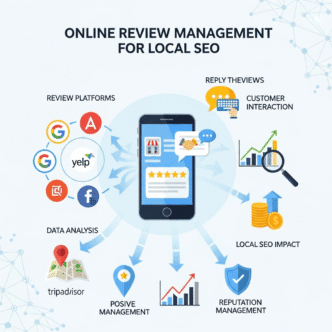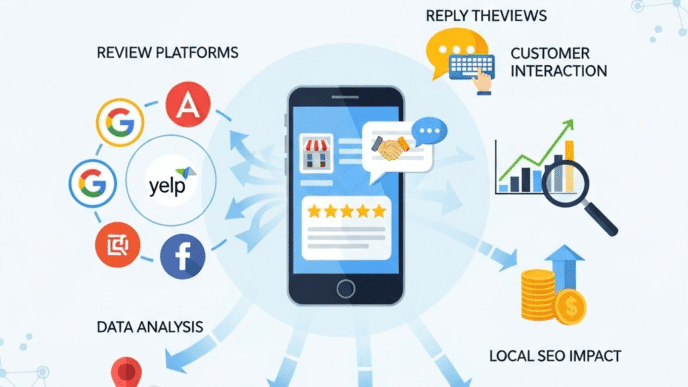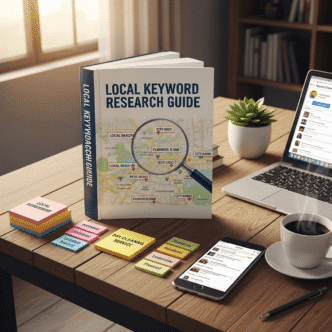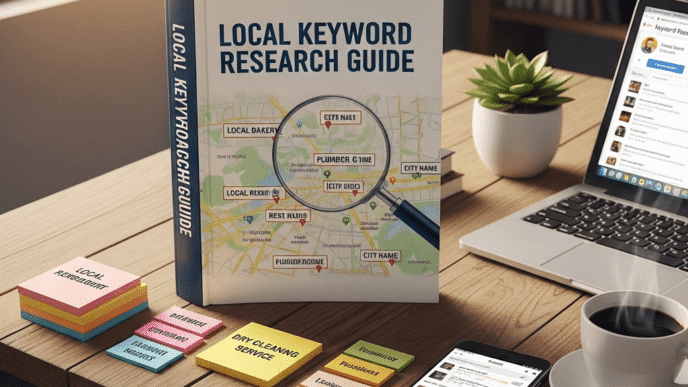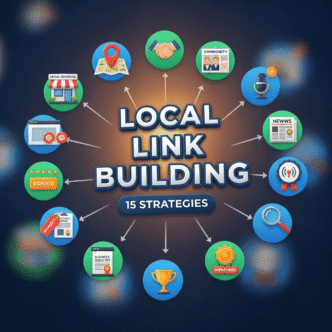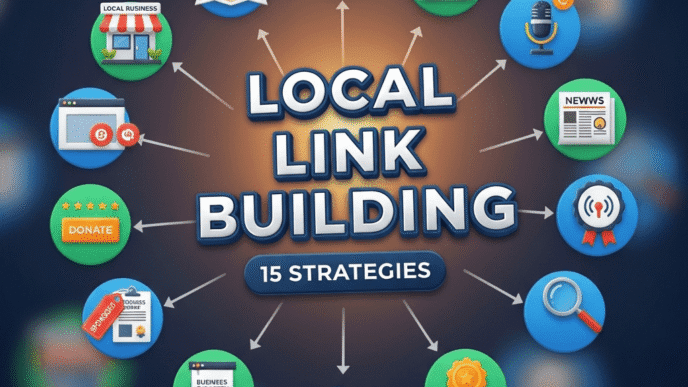You’re staring at Google’s local pack, and it’s the same three businesses that have been there for years. They have hundreds of reviews, decades of history, and seemingly unlimited marketing budgets.
Meanwhile, you’re the new kid on the block—or maybe you’ve been around but just can’t break into the top spots. Every time you check, those same established competitors are hogging all the visibility, all the calls, and all the customers.
Here’s what most people don’t realize: competitive local SEO isn’t about outspending the big players. It’s about outthinking them.
The businesses dominating your local market got comfortable. They stopped innovating. They’re relying on legacy rankings and haven’t adapted to how local search works in 2025. And that’s your opening.
This guide will show you exactly how to compete with—and beat—established local competitors, even if you’re starting from behind. We’re talking strategic warfare, not fair fights.
Table of Contents
ToggleWhy Competing in Local Search Is Harder Than Ever (But Not Impossible)
Let’s get real about competing in local search in 2025.
The local SEO landscape has matured. The businesses ranking in your market have been optimizing for years. They have massive review counts, well-established citation profiles, and domain authority you can’t match overnight.
But here’s the good news: they also have weaknesses.
The Competitive Landscape Has Changed
What’s harder now:
- Established businesses have built significant authority over years
- Review counts create a huge moat (100+ reviews vs. your 5)
- Google favors businesses with consistent, long-term presence
- Big budgets can drown out smaller competitors
- Customer loyalty makes it hard to steal market share
What’s easier now:
- Most established businesses got lazy with their local SEO
- Google’s algorithm changes frequently create new opportunities
- Niche specialization can beat general positioning
- Modern tactics (video, AI content, hyperlocal targeting) aren’t widely adopted yet
- Google prioritizes relevance and user experience over pure age
Pro Tip: Your competitive disadvantage is actually your advantage. You’re hungry, nimble, and willing to do what established competitors won’t. That matters more than you think.
The Three Types of Local Competitors You’ll Face
1. The Legacy Dinosaur
- Been around 20+ years
- Massive review count but mostly old reviews
- Outdated website and mediocre GBP
- Ranking on reputation alone
- Vulnerable to: Modern optimization, better UX, fresh reviews
2. The Well-Optimized Competitor
- Actively managing their local SEO
- Strong GBP, good content, decent backlinks
- Hardest to beat head-on
- Vulnerable to: Niche positioning, content differentiation, hyperlocal focus
3. The Budget Giant
- National chain or franchise with deep pockets
- Strong brand recognition
- Corporate SEO resources
- Vulnerable to: Personal service angle, community connection, specialized expertise
Understanding which type you’re fighting changes your strategy completely.
How to Conduct a Competitive Local Market SEO Analysis That Reveals Weaknesses
You can’t beat competitors you don’t understand. Analyzing local SEO competitors is your first strategic move.
Step 1: Identify Your Real Competitors
Don’t just guess—let the data tell you.
Method 1: Check the local pack Search your primary keywords and note which businesses appear in the top 3 local results. These are your primary competitors.
Method 2: Use BrightLocal’s competitive analysis Enter your business and location. It shows who’s competing for the same keywords and ranking alongside you.
Method 3: Check Google Business Profile categories Your competitors aren’t just businesses offering your service—they’re businesses Google categorizes similarly.
Pro Tip: Your real competitors might surprise you. Sometimes it’s not the obvious business down the street—it’s someone with better SEO positioning you didn’t even know about.
Step 2: Audit Competitor Google Business Profiles
This is where you’ll find the most actionable intelligence.
What to analyze:
Reviews:
- Total count
- Average rating
- Review velocity (reviews per month)
- Review recency (when was the last one?)
- Response rate and quality
- Common themes in reviews
GBP Optimization:
- Completeness (are all sections filled?)
- Photo quantity and quality
- Update frequency (posts, photos)
- Category selection (primary and secondary)
- Attributes (wheelchair accessible, etc.)
- Q&A section activity
Engagement signals:
- How many people are calling?
- How many requesting directions?
- Website click patterns
You can’t see their exact numbers, but you can see relative popularity through Google Maps.
Step 3: Analyze Competitor Websites
Technical analysis:
Use tools like:
- PageSpeed Insights for speed comparison
- Screaming Frog for technical SEO audit
- Ahrefs or SEMrush for backlink profile
What to look for:
- Page speed (are they slow? That’s your opportunity)
- Mobile experience (is it clunky?)
- Local content quality
- Location page structure
- Service page comprehensiveness
- Schema markup implementation
Content analysis:
Questions to answer:
- Do they have location-specific content?
- Are they targeting long-tail keywords you could own?
- Is their content outdated?
- Do they have a blog? How often do they publish?
- Are they creating video content?
- Do they cover topics you could cover better?
Step 4: Review Their Backlink Profile
Backlinks are still a major ranking factor for competitive local market SEO.
Use Ahrefs, Moz, or SEMrush to identify:
- Total referring domains
- Quality of links (Domain Rating/Authority)
- Top linking pages
- Local links (chamber of commerce, local news, etc.)
- Industry-specific links
- Link gaps (sites linking to them but not you)
Pro Tip: Don’t just count links—assess quality. 10 links from local news sites beat 100 from random directories.
Step 5: Create a Competitive Comparison Matrix
Put it all in a spreadsheet:
| Metric | Your Business | Competitor A | Competitor B | Competitor C |
|---|---|---|---|---|
| GBP Reviews | 23 | 187 | 94 | 312 |
| Average Rating | 4.8 | 4.3 | 4.6 | 4.5 |
| Recent Reviews (last 30 days) | 3 | 1 | 4 | 2 |
| GBP Photos | 47 | 23 | 156 | 89 |
| Website Speed (mobile) | 2.1s | 4.7s | 3.2s | 5.1s |
| Referring Domains | 34 | 156 | 78 | 203 |
| Local Content Pages | 8 | 2 | 12 | 5 |
| Blog Posts (last 6 months) | 12 | 0 | 3 | 1 |
| Video Content | Yes | No | No | No |
This matrix reveals exactly where you can compete and where you need to improve.
Step 6: Identify the Gaps and Opportunities
Look for patterns:
Where are ALL competitors weak?
- Nobody’s publishing fresh content? Own content.
- Everyone has slow websites? Speed is your advantage.
- No one’s using video? That’s your opening.
Where can you compete today?
- Review generation (you can catch up in 6-12 months)
- Content freshness (you can publish now)
- Niche specialization (position differently)
- User experience (better website, faster, clearer)
Where will you always be behind?
- Domain age (can’t change this, so don’t compete on it)
- Total review count (will take years to match)
- Brand recognition (requires different marketing)
The smart strategy? Compete where you can win today while building assets for long-term competition.
Strategic Approaches for Outranking Local Competitors
Now that you know the battlefield, let’s talk tactics for outranking local competitors.
Strategy #1: The Niche Domination Play
Instead of being “a plumber,” become “the emergency plumber” or “the eco-friendly plumber” or “the historic home plumbing specialist.”
Why this works:
- Less competition for specific niches
- Higher conversion rates (you’re exactly what people need)
- Easier to build authority in a narrow space
- Allows for premium pricing
How to implement:
Choose your niche based on:
- Market gaps (what are competitors NOT offering?)
- Your actual expertise or interest
- Profitability (is there demand?)
- Defensibility (can you own it?)
Examples of niche positioning:
- “Denver’s only certified Tesla EV charging installer”
- “Historic home HVAC specialists serving homes built before 1950”
- “Emergency 24/7 plumbing for restaurants and commercial kitchens”
- “Pediatric dentistry with sensory-friendly environment for special needs kids”
Optimize everything for your niche:
- GBP description emphasizes niche
- Website homepage clearly states niche
- Content targets niche keywords
- Reviews mention niche services
- Photos showcase niche work
Pro Tip: A niche doesn’t mean you ONLY do that work—it means that’s what you’re known for. You can still take general work, but your marketing focuses on the niche.
Strategy #2: The Hyperlocal Domination Play
Instead of competing citywide, dominate specific neighborhoods first.
Why this works:
- Rankings are proximity-based
- Easier to build neighborhood authority
- Local partnerships are more accessible
- Community engagement is more manageable
How to implement:
Pick 2-3 target neighborhoods:
- Where you actually want customers
- Where competition is weaker
- Where you already have some presence
Create neighborhood-specific assets:
- Detailed location pages mentioning specific streets, landmarks
- Content about neighborhood-specific issues
- Partnerships with neighborhood businesses
- Sponsorships of neighborhood events
- Reviews mentioning specific neighborhoods
Example: A locksmith in Boston focuses on Beacon Hill, Back Bay, and South End instead of trying to rank for all of Boston. Within 6 months, they’re #1 in the local pack for all three neighborhoods.
Build neighborhood signals:
- Get links from neighborhood association websites
- Sponsor youth sports in specific neighborhoods
- Partner with real estate agents focused on those areas
- Create “Neighborhood Guide” content
For more foundational strategies that support this approach, explore this comprehensive local SEO guide.
Strategy #3: The Review Velocity Attack
You can’t match a competitor’s 300 reviews overnight. But you CAN beat them on review velocity and recency.
Why this works:
- Google weights recent reviews heavily
- Fresh reviews signal business health
- High velocity shows momentum
- Review recency affects rankings
How to implement:
Set aggressive review goals:
- Aim for 10-20 new reviews per month
- Make it systematic, not random
Create a review generation system:
Immediate post-service request: “Thanks for choosing us! If you were happy with [Service Person’s Name]s work, a quick Google review would really help us serve more neighbors like you: [Direct Review Link]”
Follow-up sequence:
- Day 1: Thank you email with review request
- Day 3: Text message with review link
- Day 7: Final follow-up email
In-person request with QR code: Show a QR code that goes directly to your Google review page. Ask while the positive experience is fresh.
Pro Tip: Focus on getting reviews that mention specific services and locations. “Great plumber!” is fine, but “Fixed our water heater in Capitol Hill quickly!” is gold for SEO.
Strategy #4: The Content Superiority Play
Most local businesses have terrible content. You can win by being 10x better.
Why this works:
- Content builds topical authority
- Attracts backlinks naturally
- Captures long-tail search traffic
- Positions you as the expert
How to implement:
Create pillar content pieces:
- Comprehensive guides (3,000+ words)
- Local resource pages
- Answer guides for common questions
- Comparison content
Examples:
- “Complete Guide to [Your Service] in [City]: Cost, Timeline, and What to Expect”
- “[City] Homeowner’s Guide to [Problem You Solve]”
- “Before You Hire a [Your Service] in [City]: 10 Questions to Ask”
Update competitor content better:
Find their top-performing content (use Ahrefs to see what drives their traffic). Create a better, more comprehensive version.
Add unique local angles:
- Local regulations and codes
- Climate-specific considerations
- Neighborhood-specific issues
- Local case studies
Publish consistently:
- Aim for 2-4 high-quality posts per month
- Mix educational, local, and service-focused content
- Repurpose into videos, social posts, email content
Strategy #5: The Technical Excellence Play
If competitors have slow, broken, or outdated websites, technical excellence is your weapon.
Why this works:
- Google prioritizes Core Web Vitals
- Mobile experience affects rankings
- Speed impacts conversion rates
- Technical health signals quality
How to implement:
Speed optimization:
- Target under 2 seconds on mobile
- Compress images aggressively
- Minimize JavaScript
- Use a fast host
- Implement caching
Mobile-first design:
- Large, touch-friendly buttons
- Click-to-call prominently displayed
- Simple navigation
- Fast forms
- No intrusive pop-ups
Schema markup:
- LocalBusiness schema
- Service schema
- Review schema
- FAQ schema
- Breadcrumb schema
Pro Tip: Use PageSpeed Insights to check competitors’ sites. If they’re slow, you have a clear advantage to exploit by being fast.
Strategy #6: The Video Domination Play
Most local businesses still aren’t creating video content. That’s crazy.
Why this works:
- Video results appear in search
- YouTube is the #2 search engine
- Builds trust faster than text
- Google prioritizes diverse content types
How to implement:
Create these video types:
Service explanation videos: “What to expect when you hire us for [service]”
FAQ videos: Answer the top 10 questions you get from customers
Behind-the-scenes content: Show your team, your process, your values
Customer testimonials: Video reviews are incredibly powerful
Local area content: “Serving [Neighborhood Name]: Why we love this community”
Optimization for local search:
- Include city/neighborhood in video title
- Add location in description
- Tag with local keywords
- Embed videos on relevant location pages
- Create YouTube playlist for each service area
Strategy #7: The AI-Enhanced Content Play
AI is changing content creation, and early adopters have an edge in beating competitors locally.
Why this works:
- Create more content faster
- Personalize at scale
- Analyze competitor gaps more efficiently
- Optimize existing content based on search intent
How to implement:
Use AI for competitive research:
Tools like ChatGPT or Claude can analyze competitor content and identify gaps:
“Here are the top 3 competitor pages for ’emergency plumber Denver.’ Analyze what they cover and what topics they miss that I could address.”
Use AI for content ideation:
“Generate 20 blog post ideas for a plumbing business in Denver that would attract homeowners with plumbing emergencies.”
Use AI for content optimization:
“Review my location page and suggest improvements based on search intent for ‘plumber in [neighborhood].'”
Use AI for schema generation:
“Create LocalBusiness schema markup for my plumbing business serving Denver.”
Don’t use AI for:
- Complete content replacement (it’s obvious and generic)
- Review responses (customers can tell)
- Creating fake local expertise
Pro Tip: Use AI as a research assistant and first-draft generator, but always add your unique local knowledge, real examples, and personality. That’s what competitors can’t replicate.
Advanced Tactics for Winning Local Search in Competitive Cities
Ready to play hardball? These advanced strategies separate the winners from the rest.
Tactic #1: Strategic Local Link Building
Links still matter enormously for local SEO competition analysis. But not all links are equal.
High-value local link opportunities:
Local news coverage:
- Pitch stories about your community involvement
- Offer expert commentary on local issues
- Announce unique services or achievements
- Create newsworthy surveys or research
Local resource pages:
- Find “best [service] in [city]” roundups
- Pitch to be included with unique differentiators
Local business partnerships:
- Complementary businesses (plumber + electrician)
- Suppliers and vendors
- Industry associations
- Co-marketing opportunities
Local sponsorships:
- Youth sports teams
- Charity events
- Community festivals
- School programs
Local chambers and business organizations:
- Join and actively participate
- Volunteer for committees
- Sponsor events
- Contribute to newsletters
Tactic #2: Strategic GBP Optimization That Competitors Miss
Most businesses set up their Google Business Profile and forget it. These optimizations compound over time.
Posts strategy:
- Publish 2-3 posts per week minimum
- Mix offers, updates, events, and content
- Include photos in every post
- Add call-to-action buttons
- Use local keywords naturally
Q&A section dominance:
- Seed your own Q&A with common questions
- Answer comprehensively with local keywords
- Monitor and respond to user questions within hours
- Ask satisfied customers to submit positive questions
Attributes optimization:
- Enable every relevant attribute
- Update seasonal attributes (holiday hours, etc.)
- Highlight unique features competitors don’t have
Photo strategy:
- Upload 10+ photos monthly
- Use descriptive filenames (denver-plumber-truck.jpg)
- Show team, work, results, behind-scenes
- Encourage customers to add photos
Messaging response time:
- Enable messaging on GBP
- Respond within 5 minutes during business hours
- Quick responses boost rankings
Pro Tip: Google weights engagement heavily. More actions (clicks, calls, directions) relative to views improves your rankings. Make your listing irresistible.
Tactic #3: Conquest Targeting with Paid + Organic
This is aggressive but effective—target competitor brand names.
Ethical approach:
- Use competitors’ branded terms in content naturally
- Create comparison content (“Alternative to [Competitor]”)
- Rank for “[Competitor] vs [Your Business]”
- Bid on competitor branded keywords in Google Ads (where legal)
Why this works:
- Captures people already considering your competitors
- Shows up when someone’s researching options
- Positions you as a credible alternative
Example content: “Looking for alternatives to [Big Chain]? Here’s why local customers choose [Your Business] for [service] in [city].”
Important: Don’t badmouth competitors. Position based on your strengths (personal service, local expertise, faster response, etc.).
Tactic #4: Customer Experience as SEO Strategy
Here’s what most businesses miss: customer experience affects rankings indirectly but powerfully.
How CX impacts SEO:
- Better experience = better reviews
- Better reviews = better rankings
- Faster response = more conversions
- More conversions = stronger signals to Google
CX improvements that boost SEO:
Speed:
- Answer calls faster
- Respond to messages faster
- Show up on time
- Complete work efficiently
Communication:
- Set clear expectations
- Provide updates proactively
- Follow up after service
Convenience:
- Easy online booking
- Flexible scheduling
- Multiple payment options
- Clear pricing
Going above and beyond:
- Small unexpected touches
- Handwritten thank-you notes
- Follow-up calls to ensure satisfaction
Pro Tip: The best review generation strategy is providing such good service that customers WANT to leave reviews without being asked.
Tactic #5: Multi-Platform Dominance
Don’t just optimize Google—own every platform where local customers search.
Platforms to dominate:
Facebook:
- Complete business page
- Regular posts
- Engage with local community groups
- Encourage check-ins and reviews
Nextdoor:
- Business page with recommendations
- Engage in neighborhood discussions (helpfully, not spammy)
- Sponsor local deals
Yelp:
- Complete profile
- Respond to all reviews
- Add photos regularly
- Claim special offers
Industry-specific platforms:
- Angi (Angie’s List) for home services
- Avvo for lawyers
- Healthgrades for medical
- Houzz for home design
Why this matters:
- Many customers check multiple platforms
- Links from these platforms help rankings
- Reviews aggregate across platforms
- Increases your overall visibility footprint
Real-World Case Study: How a Startup Beat 20-Year Competitors in 9 Months
Let’s look at how how to compete in saturated local markets actually works in practice.
Business: Peak Performance HVAC (Denver, CO)
Market: Extremely competitive—over 200 HVAC companies in Denver metro
Challenge:
- New business (opened January 2024)
- Zero reviews
- No website traffic
- Competing against established companies with 100+ reviews and decades of history
- Limited budget ($2,000/month for marketing)
Competitive Analysis Revealed:
- Top 3 competitors had 150-300 reviews but hadn’t gotten a new review in 30+ days
- All competitor websites were slow (4+ seconds load time)
- Nobody was creating video content
- None were targeting specific neighborhoods with content
- Most had generic service pages with no local angle
Strategy Implemented:
Month 1-2: Foundation
- Launched fast, mobile-optimized website (1.2s load time)
- Created detailed service pages with Denver-specific content
- Set up GBP with complete optimization
- Implemented call tracking
- Created initial content (10 blog posts covering Denver HVAC topics)
Month 3-4: Niche Positioning
- Pivoted to “Denver’s emergency HVAC specialists”
- Created “2-hour response guarantee” for emergencies
- Optimized all content around emergency services
- Added 24/7 messaging and quick-response system
Month 5-6: Review Velocity Attack
- Implemented systematic review request process
- Got 47 reviews in 60 days (averaging 0.75 reviews per day)
- Every review mentioned Denver or specific neighborhoods
- Responded to every review within 2 hours
Month 7-8: Hyperlocal Content
- Created individual pages for 8 Denver neighborhoods
- Published case studies from each neighborhood
- Got featured in 3 neighborhood newsletters
- Partnered with 2 local real estate agents
Month 9: Video + Advanced Tactics
- Created 12 YouTube videos showing common Denver HVAC issues
- Launched “Meet Your Technician” video series
- Embedded videos on location pages
- Got featured in Denver Post for innovative approach
Results After 9 Months:
| Metric | Month 1 | Month 9 | Change |
|---|---|---|---|
| GBP Views | 12/month | 2,840/month | +23,566% |
| Phone Calls | 3/month | 187/month | +6,133% |
| Local Pack Ranking (emergency HVAC Denver) | Not ranking | #2 | +∞ |
| Reviews | 0 | 94 | +94 |
| Average Rating | N/A | 4.9 | N/A |
| Organic Traffic | 15/month | 1,670/month | +11,033% |
| Monthly Revenue | $8K | $147K | +1,738% |
Key Tactics That Made the Difference:
1. Niche positioning (emergency services) allowed them to compete on relevance, not age
2. Review velocity (47 reviews in 60 days) signaled business momentum to Google
3. Hyperlocal content helped them rank for neighborhood-specific searches
4. Technical excellence (fast site) provided better user experience than competitors
5. Video content gave them visibility competitors didn’t have
The Lesson: They didn’t try to beat 20-year companies at their own game. They found weaknesses, positioned differently, and executed relentlessly on tactics competitors ignored.
Tools and Resources for Competitive Local SEO
Here are the tools that make competitive local SEO analysis and execution possible.
Competitive Analysis Tools
| Tool | Best For | Price | Key Feature |
|---|---|---|---|
| BrightLocal | Multi-location competitive tracking | $39-$249/mo | Citation and rank comparison |
| SEMrush | Comprehensive competitor research | $130-$500/mo | Keyword gap analysis |
| Ahrefs | Backlink analysis | $99-$999/mo | Competitor backlink profiles |
| Local Falcon | Geographic rank tracking | $30-$105/mo | Map-based competitor rankings |
| SpyFu | Competitor PPC and organic research | $39-$299/mo | Historical competitor data |
| Moz Local | Citation and reputation management | $99-$249/year | Competitive citation analysis |
Implementation Tools
For reviews:
- Podium, Birdeye, GatherUp
- Best for: Automated review requests
For content:
- Clearscope, SurferSEO
- Best for: Content optimization against competitors
For speed:
- GTmetrix, PageSpeed Insights
- Best for: Technical performance comparison
For local links:
- HARO (Help a Reporter Out)
- Best for: Earning media mentions
Free Tools You Can’t Ignore
Google Business Profile Insights: See how you compare to similar businesses in your area
Google Search Console: Monitor which keywords you’re ranking for vs. competitors
Ubersuggest: Basic keyword and competitor research
Answer the Public: Find questions competitors aren’t answering
Google Trends: Compare search interest between you and competitors
For comprehensive guidance on implementing these tools effectively, check out this complete local SEO resource.
Common Mistakes When Trying to Beat Local Competitors
Let’s talk about what NOT to do when attempting to outrank established local businesses.
Mistake #1: Copying Competitors Instead of Differentiating
The trap: “My competitor ranks #1, so I’ll just copy everything they do.”
Why it fails: You’ll always be playing catch-up, and Google rewards differentiation
The fix: Analyze what they do well, but find your unique angle. Position differently, target different keywords, serve a specific niche.
Mistake #2: Trying to Compete on Everything at Once
The trap: “I need to rank for every service in every neighborhood immediately.”
Why it fails: Spreading resources too thin means you win nowhere
The fix: Pick 1-2 services and 2-3 neighborhoods to dominate first. Build authority there, then expand.
Mistake #3: Obsessing Over What You Can’t Control
The trap: “My competitor has 200 reviews and has been in business for 30 years. I can never beat them.”
Why it fails: Defeatist attitude prevents you from focusing on what you CAN control
The fix: Accept what you can’t change (their history, their review count), focus maniacally on what you can (review velocity, content quality, user experience, niche positioning).
Mistake #4: Neglecting Fundamentals While Chasing Advanced Tactics
The trap: “I need to build 100 backlinks and create 50 videos before I’m competitive.”
Why it fails: If your GBP isn’t complete, your website is slow, and you have 3 reviews, advanced tactics won’t save you
The fix: Master the basics first:
- Complete GBP optimization
- Fast, mobile-friendly website
- Consistent review generation
- Strong location pages
- Basic citation presence
Then layer on advanced tactics.
Mistake #5: Ignoring the Customer Experience
The trap: “SEO is about tricks and tactics. Customer experience doesn’t matter for rankings.”
Why it fails: Customer experience drives reviews, repeat business, referrals, and ultimately rankings
The fix: Make delivering exceptional service your #1 priority. Everything else builds on that foundation.
Mistake #6: Being Impatient
The trap: “I’ve been optimizing for 6 weeks and I’m still not #1. This doesn’t work.”
Why it fails: Local SEO strategies for competitive industries take 3-6 months minimum to show significant results
The fix: Set realistic timelines. Celebrate small wins. Track progress weekly but judge success quarterly.
Pro Tip: Most businesses give up right before they would have seen results. The last 20% of the effort produces 80% of the results.
Future-Proofing Your Competitive Strategy for 2025 and Beyond
The local SEO landscape keeps changing. Here’s what’s coming and how to prepare.
Trend #1: AI Search Integration (Google SGE)
Google’s AI-powered search is rolling out, changing how results appear.
What this means for competitive strategy:
- Being cited in AI-generated answers becomes crucial
- Content needs to be more authoritative and comprehensive
- Traditional “position 1” might matter less
How to prepare:
- Focus on being THE authority in your niche
- Create comprehensive, cited content
- Optimize for featured snippets (AI often pulls from these)
- Build a reputation as a reliable source
Trend #2: Voice Search Dominance
Voice searches are increasingly local (“Hey Google, find a dentist near me”).
What this means for competitive strategy:
- Conversational keywords become more important
- Question-based content ranks better
- Business information accuracy is critical
How to prepare:
- Create FAQ content answering natural questions
- Optimize for long-tail conversational queries
- Ensure your GBP has complete, accurate info
- Focus on mobile optimization
Trend #3: Video-First Search Results
Google is prioritizing video content in search results.
What this means for competitive strategy:
- Competitors creating video will outrank text-only competitors
- YouTube optimization becomes part of local SEO
- Visual trust-building matters more
How to prepare:
- Start creating video content now (before competitors do)
- Optimize YouTube channel for local keywords
- Embed videos on location and service pages
- Create various video types (educational, testimonials, behind-scenes)
Trend #4: Hyperlocal Precision
Search is getting more precise—down to the street level in some cases.
What this means for competitive strategy:
- Need to optimize for specific neighborhoods, not just cities
- Proximity to searcher matters even more
- Service area specificity becomes crucial
How to prepare:
- Create neighborhood-specific content
- Build relationships in specific communities
- Get reviews mentioning specific neighborhoods
- Use hyperlocal keywords
Trend #5: Review Authenticity Enforcement
Google is cracking down harder on fake reviews and review manipulation.
What this means for competitive strategy:
- Only genuine reviews will count
- Review velocity patterns will be scrutinized
- Quality over quantity matters more
How to prepare:
- Generate reviews organically from real customers
- Vary your review request timing and methods
- Encourage detailed, specific reviews
- Never buy reviews or use manipulation services
Trend #6: First-Party Data Advantage
As third-party cookies disappear, businesses with strong first-party data win.
What this means for competitive strategy:
- Email lists become more valuable
- Customer loyalty programs matter more
- Direct relationships trump rented attention
How to prepare:
- Build your email list aggressively
- Create a customer database
- Implement loyalty programs
- Focus on repeat business and referrals
Pro Tip: The businesses that will dominate local search in 2026-2027 are the ones building these assets now. Start today.
Your 90-Day Competitive Local SEO Battle Plan
Ready to execute? Here’s your step-by-step plan for winning local search in competitive cities.
Month 1: Intelligence and Foundation
Week 1: Competitive Intelligence
- Identify your top 5 local competitors
- Complete competitive analysis spreadsheet
- Audit their GBPs, websites, content, reviews
- Identify their weaknesses and your opportunities
Week 2: Strategic Positioning
- Decide on your differentiation strategy (niche, hyperlocal, service excellence, etc.)
- Update messaging across all platforms
- Revise GBP description with positioning
- Update website homepage to reflect positioning
Week 3: Technical Foundation
- Audit website speed and fix issues (target <2s)
- Ensure mobile experience is flawless
- Implement or verify schema markup
- Fix any broken links or technical errors
- Set up call tracking
Week 4: Content Foundation
- Create or optimize 3 core service pages
- Write first 2 location-specific pages
- Publish first 2 blog posts targeting competitor gaps
- Set up content calendar for next 60 days
Month 2: Execution and Momentum
Week 5: Review Generation System
- Implement systematic review request process
- Set goal of 15-20 reviews this month
- Respond to all existing reviews
- Add review schema to website
Week 6: GBP Optimization
- Upload 20+ high-quality photos
- Seed Q&A with 10 helpful questions/answers
- Enable messaging and set up fast-response system
- Publish 3 GBP posts this week
Week 7: Content Acceleration
- Publish 2 more blog posts
- Create 2 more location pages
- Start first video content
- Reach out for first local partnership
Week 8: Link Building
- Submit to top 15 local directories
- Join chamber of commerce
- Reach out to 5 local blogs for partnership
- Create one link-
worthy local resource
Month 3: Amplification and Scale
Week 9: Video Launch
- Publish first 3 videos on YouTube
- Optimize with local keywords
- Embed videos on relevant website pages
- Share on social media and GBP
Week 10: Advanced GBP Tactics
- Publish 4-5 GBP posts this week
- Add/update all attributes
- Encourage customers to add photos
- Monitor and respond to all activity within hours
Week 11: Local PR Push
- Pitch 3 local news outlets with story ideas
- Sponsor local event
- Partner with complementary local business
- Guest post on local blog
Week 12: Analysis and Optimization
- Review all metrics from 90 days
- Identify what’s working (double down)
- Identify what’s not (adjust or eliminate)
- Set goals for next 90 days
- Celebrate wins with team
Pro Tip: Don’t try to skip ahead. Each week builds on the previous one. Rushing leads to incomplete execution, which leads to mediocre results.
Metrics to Track Weekly
Competitive positioning metrics:
- Your local pack ranking vs. top 3 competitors
- Review count differential (are you closing the gap?)
- GBP views compared to previous week
- Website traffic from local search
Engagement metrics:
- Phone calls from organic search
- Direction requests
- Website form submissions
- Conversion rate
Authority metrics:
- New reviews this week
- New backlinks earned
- New content published
- Social engagement
Create a simple scorecard and review it every Monday morning.
Advanced Competitive Intelligence: What the Pros Do
Ready for the really advanced stuff? Here’s what top competitive local market SEO specialists do.
Tactic: Track Competitor Google My Business Posts
Most competitors don’t post consistently on GBP. When they do, it reveals their strategy.
What to monitor:
- Posting frequency
- Types of posts (offers, events, updates)
- Engagement on posts
- Keywords they target
Why it matters: If a competitor suddenly starts posting frequently, they’re investing in local SEO. That’s your signal to ramp up your efforts.
How to track: Manually check weekly, or use tools like BrightLocal that monitor competitor GMB activity.
Tactic: Monitor Competitor Review Responses
How competitors respond to reviews reveals their priorities and weaknesses.
What to look for:
- Response time (do they respond within days? weeks?)
- Response quality (generic or personalized?)
- How they handle negative reviews
- Keywords they use in responses (optimization opportunity)
Why it matters: Slow, generic responses signal they’re not actively managing reputation. That’s your opening to provide better experience and get better reviews.
Tactic: Track Competitor Rankings from Multiple Locations
Your rankings aren’t universal—they vary by where the searcher is located.
Why this matters: A competitor might rank #1 from their business location but #5 from across town. Understanding geographic ranking patterns reveals territory you can dominate.
How to track: Use Local Falcon to check rankings from a grid of coordinates across your city. This shows you where competitors are strong and where they’re vulnerable.
Strategic application: Focus your hyperlocal content and partnerships on areas where established competitors rank poorly.
Tactic: Set Up Competitor Alerts
Get notified when competitors make moves.
What to monitor:
- New backlinks (via Ahrefs or Moz)
- New content published (via RSS or tools like Visualping)
- New reviews (manually or via reputation management tools)
- Changes to their GBP (manually check weekly)
- Mentions in local news (Google Alerts)
Why it matters: You can’t respond to competitive moves you don’t know about. Real-time intelligence lets you adapt quickly.
Tactic: Analyze Competitor Paid Search Strategy
What competitors bid on reveals what converts for them.
Use SpyFu or SEMrush to see:
- Which keywords they’re bidding on
- Ad copy they’re using
- Landing pages for ads
- Estimated ad spend
Why it matters: If competitors invest heavily in certain keywords via paid search, those keywords likely convert. Consider targeting them organically.
Pro Tip: Don’t just track what competitors are doing—track what they’re NOT doing. The gaps are often bigger opportunities than trying to beat them head-on where they’re strong.
Frequently Asked Questions About Competitive Local SEO
How long does it take to outrank established local competitors?
Realistic timeline:
- 3-6 months: Start seeing movement in rankings for less competitive keywords
- 6-12 months: Competitive keywords show significant improvement
- 12-18 months: Can achieve top 3 rankings for primary keywords in very competitive markets
What accelerates the timeline:
- Aggressive review generation (20+ reviews in first 3 months)
- Niche positioning (easier to rank for specific terms)
- Superior content and user experience
- Strategic local link building
What slows it down:
- Highly competitive markets (law, dentistry, etc.)
- Competitors actively optimizing
- Limited resources for optimization
- Trying to compete on too many fronts simultaneously
Bottom line: Most businesses see meaningful results by month 4-6, but total dominance takes 12+ months in competitive markets.
Can a new business compete with one that has 200+ reviews?
Yes, but not head-on. You need strategy.
What you can’t compete on (yet):
- Total review count (will take years to match)
- Brand recognition
- Domain age and authority
What you CAN compete on:
- Review velocity (getting reviews faster NOW)
- Review recency (all your reviews are fresh)
- Niche positioning (they’re generalists, you’re a specialist)
- Content freshness (your content is up-to-date)
- User experience (faster site, better mobile experience)
- Video content (if they don’t have it)
- Response time (answer calls/messages faster)
Strategic approach: Focus on “emergency [service]” or “[niche] specialist” positioning rather than trying to be the general option. Capture high-intent searches where immediate need outweighs review count.
Pro Tip: A business with 50 recent reviews and a 4.9 rating can outrank one with 200 old reviews and a 4.3 rating. Velocity + quality + recency beats pure volume.
Should I report competitors who are using black hat tactics?
When to report:
- Fake reviews (clearly fabricated)
- Keyword-stuffed business names (e.g., “Joe’s Plumbing Best Plumber Denver Cheap”)
- Multiple GBP listings for same business
- Fake locations or addresses
- Spam in GBP posts or Q&A
How to report:
- Use the “Suggest an edit” feature on their GBP
- Report via Google’s Business Redressal Complaint Form
- Flag suspicious reviews individually
When NOT to report:
- Aggressive but legitimate SEO (lots of content, fast review generation)
- Better optimization than yours (that’s just competition)
- Tactics you don’t understand (research first)
Important: Focus 90% of your energy on your own optimization, 10% on reporting clear violations. Don’t become obsessed with taking down competitors—build yourself up instead.
How do I compete against national chains with huge budgets?
National chains have advantages (brand recognition, resources) and disadvantages (impersonal, corporate, slow).
Your competitive advantages:
- Personal service: You know your customers by name
- Local expertise: Deep knowledge of local issues, codes, climate
- Flexibility: Can make decisions quickly without corporate approval
- Community connection: Actually part of the local community
- Specialization: Can focus on niches chains ignore
Strategic positioning:
- Emphasize local ownership (“Locally owned since [year]”)
- Highlight personal service (“You’ll never get a call center”)
- Show community involvement (sponsorships, local partnerships)
- Offer flexibility chains can’t (“We’ll work around your schedule”)
Content strategy:
- Create local comparison content (“Why choose a local [service] over national chains”)
- Highlight local case studies
- Feature your local team members
- Cover local issues chains ignore
Example: A local pizza restaurant can’t compete with Domino’s on price or convenience. But they can win on “authentic Italian recipes,” “family-owned since 1985,” “voted best pizza by [Local Paper],” and “we source ingredients from local farms.”
What if my competitor is my spouse’s cousin’s best friend’s business?
Welcome to small-town local SEO! This is awkward but common.
Professional approach:
- Compete on marketing, not through badmouthing
- Never mention them negatively in public
- Focus on your differentiators without comparing
- Consider different niche positioning to reduce direct conflict
- Be gracious if you see them at family gatherings
Business is business: It’s not personal to optimize your GBP, create better content, and ask for reviews. That’s professional competition.
When to collaborate: If your niches are different enough, consider partnerships. Maybe they focus on residential and you focus on commercial. Or vice versa.
Pro Tip: The local business community is smaller than you think. Maintain professional relationships even with competitors—you never know when you might want to refer overflow work or eventually partner.
How many competitors should I track?
Primary competitors: 3-5 These are businesses directly competing for the same keywords and customers.
- Track weekly
- Analyze deeply (GBP, website, content, links, reviews)
- Model successful tactics
- Identify opportunities they miss
Secondary competitors: 5-10 These compete occasionally or in specific sub-niches.
- Track monthly
- Monitor for major changes
- Learn from their successes
Tertiary competitors: 10-20 These are in your industry but not direct threats.
- Track quarterly
- Scan for industry trends
- Identify potential partnerships
Don’t track everyone: You’ll drive yourself crazy and lose focus. Pick the competitors that actually affect your rankings and business.
Should I ever collaborate with competitors?
Yes! Collaboration can benefit everyone.
Collaboration opportunities:
Referral networks: “I’m booked this week, but [Competitor] does great work and might have availability”
Content partnerships: “10 best [service providers] in [city]” roundup posts (everyone links to it)
Event sponsorships: Split costs for community event sponsorship
Knowledge sharing: Industry associations, conferences, informal meetups
Pro Tip: The competitors who become friends are the ones who share industry knowledge, refer overflow work, and even discuss marketing tactics. Abundance mindset beats scarcity mindset.
What’s the single most important factor in beating competitors?
If I had to pick one: Consistent execution over time.
Most businesses:
- Start strong for 2 months
- Get busy and stop optimizing
- Check rankings sporadically
- Post on GBP inconsistently
- Generate reviews in spurts
Winners:
- Optimize consistently every week
- Track metrics religiously
- Publish content on schedule
- Generate reviews systematically
- Respond to everything promptly
- Never stop improving
The turtle beats the hare: Competitors who sprint for 3 months then quit always lose to businesses that show up every single week for years.
Pro Tip: Set up systems and processes so local SEO happens even when you’re busy. Block off Friday mornings for optimization. Create a content calendar. Automate review requests. Make it systematic, not sporadic.
Final Thoughts: Competing Is a Marathon, Not a Sprint
Here’s the reality of competitive local SEO: most businesses won’t do what you just learned.
They’ll read this guide, nod along, think “great ideas,” and then do nothing. Or they’ll try for a month, not see instant results, and quit.
That’s your advantage.
The businesses that dominate local search in competitive markets aren’t necessarily smarter or better—they’re more consistent and strategic. They show up every week. They track metrics. They adjust based on data. They never stop optimizing.
The competitive moat you’re building:
- Every review makes the gap bigger
- Every piece of content compounds
- Every backlink strengthens your authority
- Every optimization builds momentum
Six months from now, you can either be wishing you’d started today, or celebrating results from the work you’re about to begin.
Your competitive advantage isn’t just in tactics—it’s in mindset:
- You don’t need to be better than competitors at everything
- You need to be exceptional at 3-5 things that matter most
- You need to be consistent when they’re sporadic
- You need to focus on what you can control
The local market is competitive, yes. But it’s also full of lazy, complacent businesses who stopped trying years ago. They’re coasting on legacy rankings and old reviews.
You’re hungry, strategic, and armed with a plan. That matters more than you think.
Stop waiting for the perfect moment. Start implementing today. Your future self—and your bank account—will thank you.
For the foundational tactics that support everything you’ve learned here, explore this complete guide to local search domination.
Now go take what’s yours. The local pack has three spots, and one of them has your name on it.
What’s your first move? Pick ONE tactic from this guide and implement it this week. Don’t try to do everything—pick one, do it excellently, then move to the next.
The competition isn’t going to beat itself. But with the right strategy and relentless execution, you don’t need to be the biggest or the oldest to win. You just need to be smarter and more consistent.
Game on.
Local SEO Competitive Analysis Dashboard
Track, compare, and outrank your local competitors
Competitive Landscape Overview
📊 Review Count Comparison
💡 Focus: Generate 15-20 reviews monthly to close the gap within 12 months
🎯 Competitive Strengths & Weaknesses
Rating (4.8), Site Speed (2.1s), Mobile UX
Reviews, Backlinks, Content Volume
📋 Detailed Competitor Metrics
| Business | Reviews | Rating | Backlinks | Speed (s) |
|---|---|---|---|---|
| Your Business ⭐ | 23 | 4.8 | 34 | 2.1s |
| Competitor A | 187 | 4.3 | 156 | 4.7s |
| Competitor B | 94 | 4.6 | 78 | 3.2s |
| Competitor C | 312 | 4.5 | 203 | 5.1s |
📈 Ranking Progress Timeline
Local Pack Ranking Trend (Last 6 Months)
🚀 Winning Strategies for Your Market
Review Velocity Attack
Generate 15-20 reviews per month to signal momentum and close the review gap with established competitors.
- Post-service SMS requests with direct review link
- QR codes on invoices and business cards
- Automated email follow-up sequence
Niche Positioning
Dominate a specific service niche competitors ignore. Position as the specialist rather than generalist.
- Emergency services specialization
- Industry-specific certifications
- Unique service guarantees
🎯 90-Day Action Plan
Month 1: Focus on Review Velocity Attack + Technical Excellence (site speed, mobile UX)
Month 2: Launch Niche Positioning + Create 4-6 hyperlocal content pieces
Month 3: Video content launch + Local link building campaign
This interactive dashboard provides a comprehensive competitive analysis for local SEO campaigns. All data represents typical competitive scenarios in saturated local markets.
💡 For personalized competitive analysis and strategies, visit seoprojournal.com









